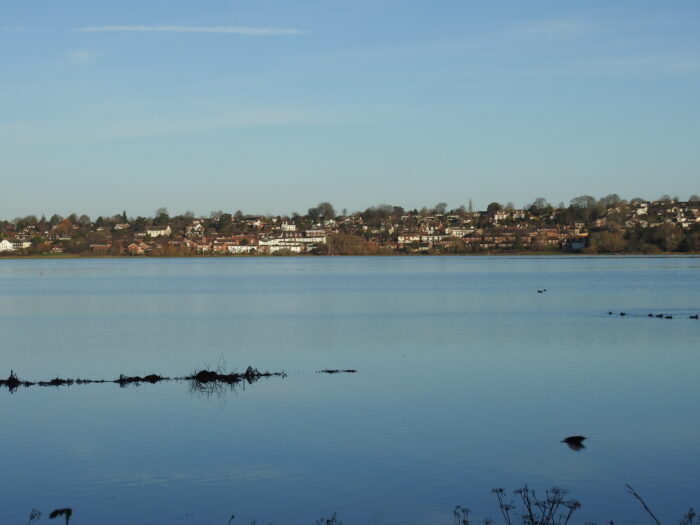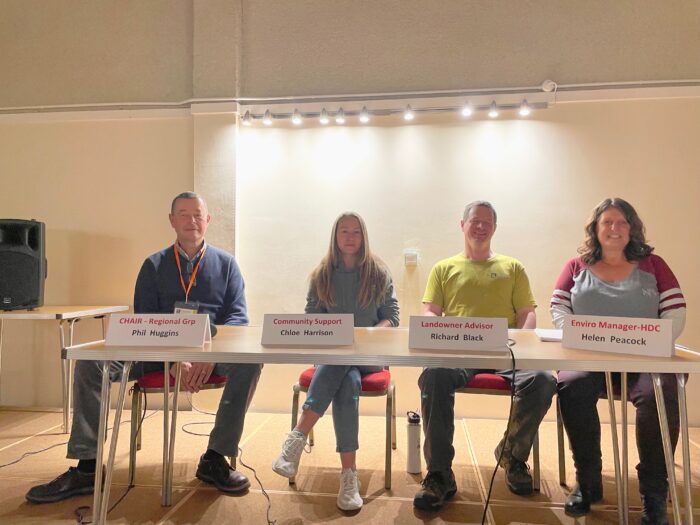A new group in West Sussex aims to tackle the climate emergency at local level. This blog by SWT Storrington and Arun Valley Regional Group vice-chair, Viviane Doussy, outlines plans to engage local communities in scalable projects to create safe routes for wildlife.

Arun Valley in flood, Dec 2019 – (Photo: Paul Davy)
Covid crept in and we all got inspired by nature’s clear blue skies and clean air plus the sanctuary that even a small garden afforded us. It gave us the impetus to look at what else people could do at a local level to build nature connections and wildlife corridors.
At a time when COP diplomacy and outcomes are at a critical level, we have established a practical force for good in the Arun Valley area. A new Sussex Wildlife Trust (Storrington and Arun Valley) Regional Group has been set up affiliated to SECA. We launched at the end of September with a successful, Covid-aware public event in Storrington, West Sussex.
At this event, Sussex Wildlife Trust’s President, Dr Tony Whitbread took us on a journey. He described how, despite all of the Wildlife Trust’s successes in the 60 years of its lifespan, we continue to lose the battle against the biodiversity decline. The UN Decade of Ecosystem Restoration implores us to take massive action to restore our degraded natural ecosystems.

Wilder Horsham panel discussion
The committee are now working on a strategy and programme for 2022, and are keen to get members involved in practical projects to create corridors for wildlife. This could start with making gardens more pollinator friendly, then scale up to whole streets and local green spaces, creating staging posts where nature can gather and rest and move on. While the area has established reserves such as the Knepp Castle Estate and RSPB Pulborough Brooks, the group wants to focus on the spaces in between them to ensure safe routes for wildlife. There will also be a data gathering element to measure the impact of the initiatives.
The Covid pandemic has focused peoples’ minds on the value of their green spaces, and practical local projects can work to counter a sense that climate change is inevitable. Groups like ours have our work cut out as humanity continues to burn fossil fuels and destroy our life-giving habitats at our peril, yet our new group’s “nature everywhere” philosophy is equally applicable to any community.
Alongside the Climate COP, COP26, our eyes will be on the Biodiversity COP15 in China. The SWT headquarters at Woods Mill, Henfield, now employs a Climate Lead, Matthew Bird who was brought in to develop their climate change strategy. Several excellent webinars have been run and I’m sure there will be more.
A template for other groups?
A regional group, executing the aims of the Sussex Wildlife Trust at a local level, has not been formed since the 1980s, so we are breaking new ground in some cases whilst building on the experiences of other existing and past groups. This vibrant new group is bringing local communities together, working towards a higher purpose. Ours could be a template for other Regional Groups of the Wildlife Trusts, who similarly feel there is a place to form a new group or re-vitalise dormant ones. Together we can make a difference. We need to amplify our voice with more such groups across the Southeast.

Sarah and the wonderful kitchen team at the launch (Photo: Hugh Gilbert)
For more information:
You can contact this Sussex Wildlife Trust Storrington and Arun Valley Regional Group by sending an email to swtstorringtonregion@gmail.com.
Facebook: https://www.facebook.com/groups/savrg
Website: https://sussexwildlifetrust.org.uk/what-we-do/local-groups/storrington-arun-valley-regional-group

